Raised beds are a favorite of most gardeners. The placement of the beds can be anywhere, like over the ground of your existing garden, pavement, or concrete areas. Today, we will specifically talk about building beds over concrete areas.
Garden beds can be placed over concrete, provided the bed has adequate drainage. Placing a raised garden bed over concrete areas can prevent infestations because it doesn’t come in contact with the garden soil. But a major drawback is that concrete can restrict the deeper root growth.
Not all of us have gardens. Most people make their surrounding concrete to make the house look better.
This article will explain whether you can build garden beds over raised beds, things to consider, and the pros and cons of building beds over concrete.
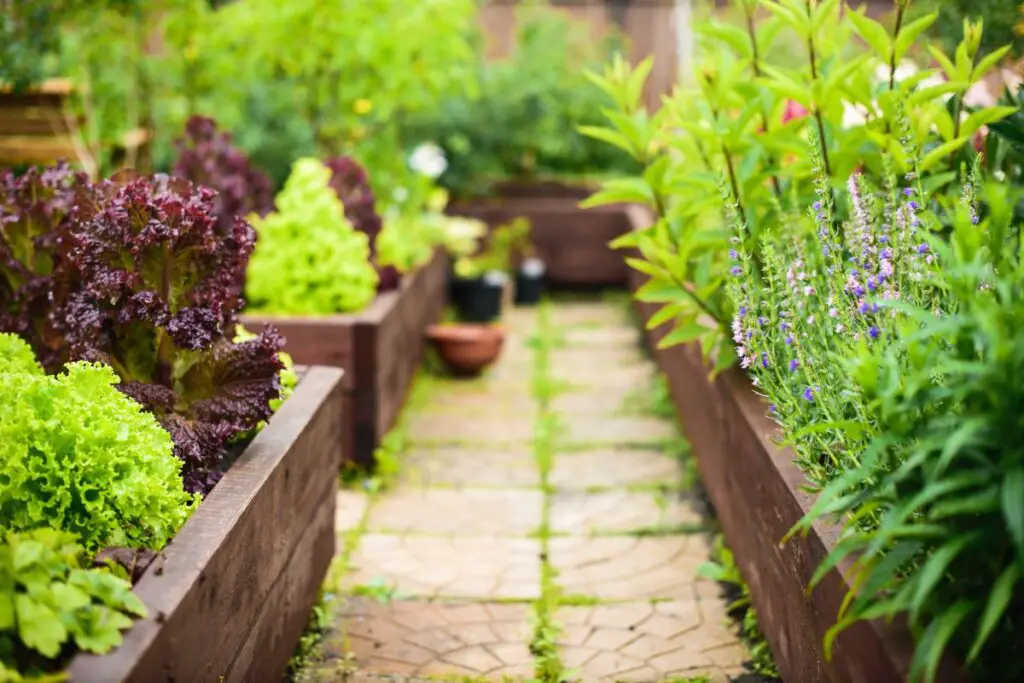
Can I build raised beds over concrete areas?
Raised beds are a great option to receive some greens at any location, be it your existing garden or some small spaces around your house.
But, building an ideal raised bed depends on where you will place it.
Most growers prefer building it in the existing garden over the ground.
However, you can also build it over concrete areas.
Many gardeners doubt whether it is fine to put raised beds over concrete areas.
Concrete areas are as great as the existing garden areas.
You only need to focus on the construction of the bed and the drainage system.
Other than that, concrete is a good place to put a garden bed for gardening.
Placing the raised beds on concrete allows you to get a flat surface where you will require rare anchoring and see less bowing of the bed.
Besides, there are fewer chances of weed growth, and you can enjoy some greenery over concrete places.
There might be a few problems like:
- The bed needs to be taller because the deep-rooted plants require enough soil to grow deeper. If the bed is small, the root growth gets restricted.
- Since there is no soil underneath to retain the moisture, the bed’s soil can dry up faster.
- If the concrete is not flat but a bit slanted, there are chances of bed bending.
However, you can solve these problems. Read on to know how you can fix these.
Explaining the methods of building a raised bed is better understood if you watch videos.
But for an estimation:
- First, decide the measurements of the bed you want and the area you want to put the bed on.
- Then cut the woods or lumber according to the measurements. If you use bricks or stones, place them properly to match the measurement specifics.
- Once you have connected the woods at every corner with braces or brackets, fill it up with the soil and start gardening. If you are using bricks, natural stones, or masonry, join the bricks or stones with plaster.
Also read: 5 Ways To Brace A Raised Garden Bed
Things to consider while placing raised beds on concrete
When you create raised beds and plan to keep them over concrete areas, you must consider certain things.
These things will help you to make the bed better suitable for concrete areas and prevent further problems.
There are a few factors because keeping over concrete places is not a big issue.
But, some things require amendments.
Now, let’s have a look at the factors.
What should be the ideal height of the raised beds on concrete?
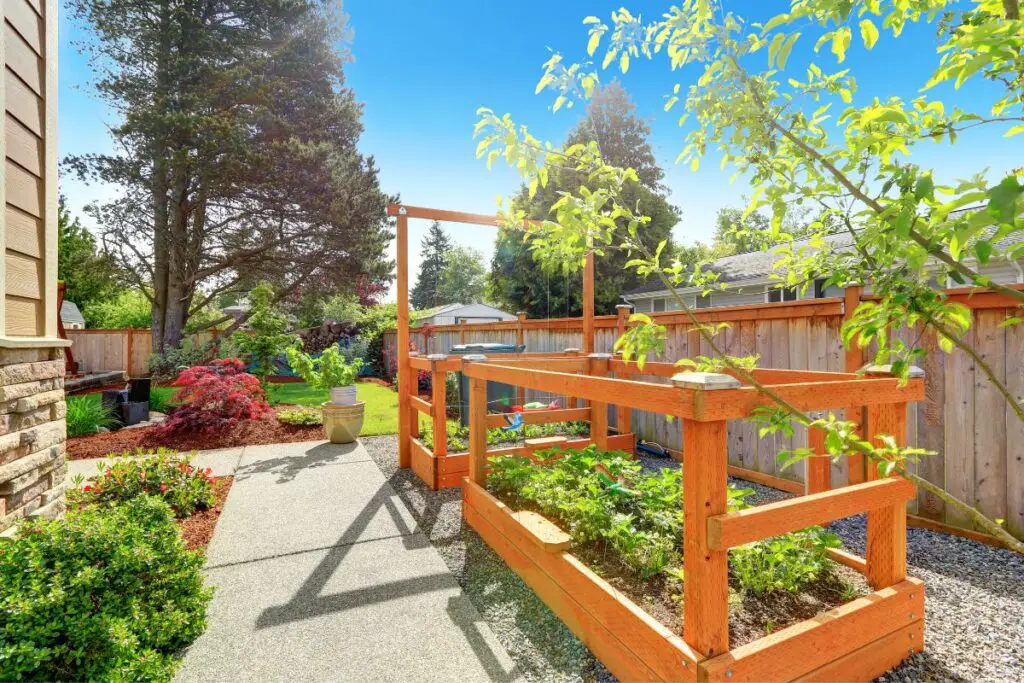
The height is essential when you create raised beds over concrete areas.
When you build a bed over the soil, the roots make their way into the ground when they don’t get enough space in the raised bed’s soil.
But, over concrete areas, the root growth will get restricted once they reach the wall at the bottom.
As a result, the plant will not develop well.
That is why it is necessary to make the bed deeper so that the roots get enough space and soil downwards to grow without restrictions.
Raised beds over the garden soil are usually around 10-12 inches higher.
It is enough space for the plants growing over the beds.
The plants will get enough access to the rich soil.
Even if the plant roots want to grow a little deeper, it won’t be a problem because there is soil underneath the bed.
In the case of concrete areas, there is no soil under the bed.
Hence, there is no place for the roots to grow deeper.
The raised bed height on concrete should be a little higher and deeper so the roots get soil for growth and don’t get restricted.
So, it has to be at least 18 inches.
Many vegetables like tomatoes, carrots, and potatoes have a deeper root system.
They need deep soil to remain healthy and strong in the long run.
Lack of adequate soil in the beds over the concrete areas won’t allow the roots to grow deeper and result in stunted growth.
Sufficient soil also helps in drainage.
If there is inadequate soil, the moisture will drain faster and leave the soil dry for a long time.
The higher the bed, the more soil it can hold.
More soil will have more moisture, and it will prevent fast drainage.
Looking for gardening supplies? We have tested 100's of products before recommending them to you guys. Check out our best pick below:
| Image | Gardening Supplies | Best Price? |
|---|---|---|
 Top
Top Top
Top | Raised Garden Bed Kit | Check On Amazon |
 | XLUX Soil Moisture Meter, Plant Water Monitor, Soil Hygrometer Sensor for Gardening, Farming, Indoor and Outdoor Plants, No Batteries Required | No Results |
 Top
Top Top
Top | 82 Pcs Garden Tools Set and Extra Succulent Tools Set | Check On Amazon |
 | Joeys Garden Expandable Garden Hose with 8 Function Hose Nozzle, Lightweight Anti-Kink Flexible Garden Hoses, Extra Strength Fabric with Double Latex Core, (50 FT, Black) | No Results |
 Top
Top Top
Top | Dual Chamber Compost Tumbler | Check On Amazon |
 Top
Top Top
Top | Sunnyglade Plant Stakes | Check On Amazon |
 Top
Top Top
Top | Organic Cold Pressed Neem Seed Oil | Check On Amazon |
 Top
Top Top
Top | Mighty Mint Gallon :-Insect and Pest Control Peppermint Oil | Check On Amazon |
 Top
Top Top
Top | Scotts DiseaseEx Lawn Fungicide | Check On Amazon |
 Top
Top Top
Top | Jacks Classic 20-20-20 All Purpose Fertilizer | Check On Amazon |
 Top
Top Top
Top | 30,000 Seeds Pollinator Attracting Wildflower Mixture | Check On Amazon |
 Top
Top Top
Top | Survival Vegetable Seeds Garden Kit-Over 16,000 Seeds | Check On Amazon |
Should there be a bottom on the raised beds?
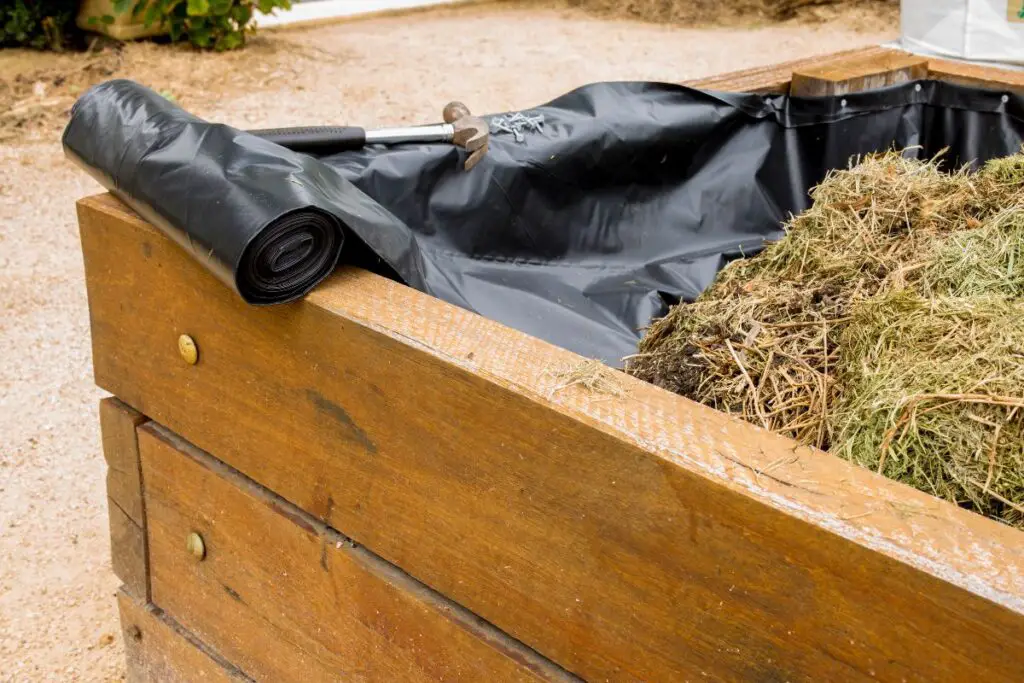
When you build a bed over a soil surface, you may or may not create a barrier at the bottom of the bed.
But, while building one over the concrete areas, you must create a barrier at the bottom to avoid waterlogging, leakages, and direct contact with the soil and concrete.
Add some liners or layer up drainage materials like gravel or stones at the bottom.
Ensure the bottom layer is at least 2-3 inches high.
Cover it with geotextile membranes or drainage fabric.
The fabric will help prevent clogging.
You don’t have to use the drainage fabric to plant deep-rooted plants like shrubs or conifers.
The plants will require a proper surface to hold themselves.
Also read: 17 Materials To Put In Bottom Of Raised Bed?
Importance of drainage in raised beds over concrete areas
After height and bottom come the importance of drainage.
Whether your bed is over the soil or concrete, drainage is important in both cases.
But, it is more important for beds that are standing over concrete areas.
The rule is to create better drainage and not fast drainage.
When you water the soil, it will drain well if you have used well-drained soil.
Water is retained in the soil if your bed is over the soil.
So, in a way, the moisture is getting drained and retained as well.
It won’t be a big issue even if you use fast-draining soil.
But in concrete areas, once the moisture drains, no soil is left under the bed to hold the water.
So, the soil will get dry frequently.
So, use soil that can keep a proper balance between moisture retention and drainage.
It should drain well and, at the same time, should remain consistently moist for some days until the next watering.
A good mixture of soil and compost would be best for raised beds.
Compost improves drainage and also retains moisture.
It also improves the nutrient level of the soil.
Avoid using potting soil as it is lightweight and drains and dries faster.
Depending on the plant’s needs, you may mulch your bed to retain the moisture a little more.
The soil’s depth also helps to retain moisture, which I already mentioned in the previous point.
Before you build a bed over a concrete place, pour water over it to understand which way the water drains.
It will help you determine which place would be perfect for beds.
Avoid two areas:
- The place where the water doesn’t stand for a minute.
- The place where the water accumulates and remains waterlogged.
What are the pros and cons of building raised beds on concrete?
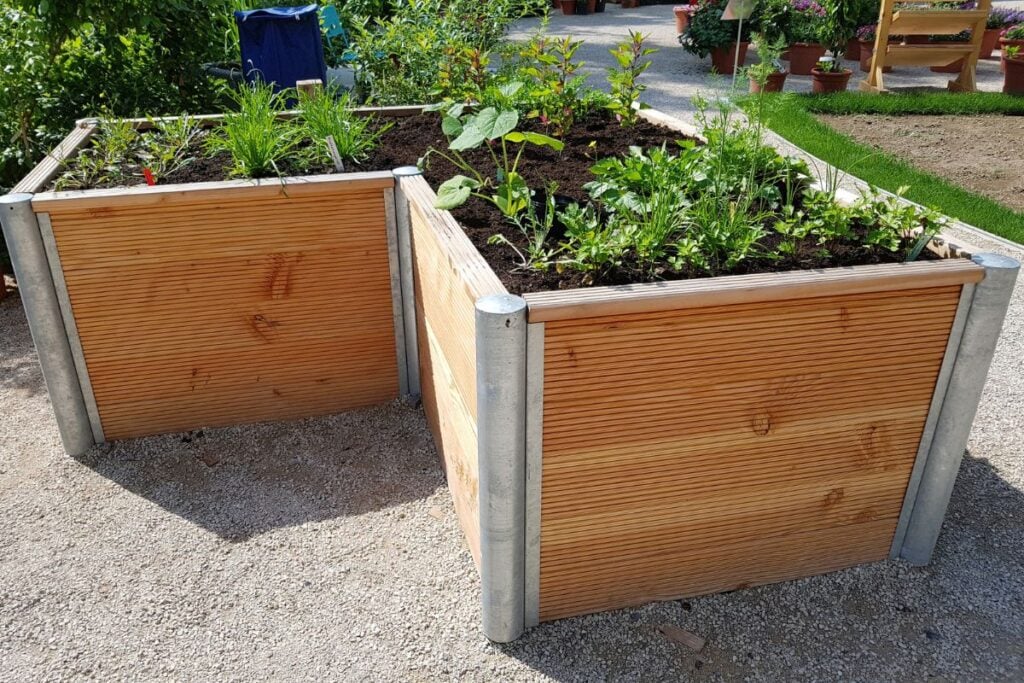
Though many people make raised beds over concrete areas, there are some good and bad sides.
You might have had some hints about it so far, but I would still like to share them for a clear understanding.
Pros of building raised beds on concrete areas
- You can start gardening at a place where people might consider it impossible.
- You can have full control over the soil type and quality.
- Raised beds are ergonomic and can prevent injuries and frequent bending, which can be a problem for older people.
- Concrete areas are sometimes flat and, thus, ideal for garden beds. If the concrete is flat and perfect, you may not have to anchor or corner brace your beds too much.
- There are lesser chances of weed growth. Those grown in the soil have higher chances of weed growth.
- Raised beds in the concrete areas make the surroundings look nice and add some greenery to the atmosphere.
Cons of raised beds over concrete areas
- There could be problems with waterlogging or fast drainage.
- If the concrete is not flat, your beds will bend and bow. There will be leakages from the bottom too.
- The growth of the deep-rooted plants will get restricted. So, it would be best if you put extra effort into making the bed taller.
- You will need a lot of soil content for a tall bed to fill it up. That will be costly.
- The plants don’t get the usefulness of the beneficial earthworms and bacteria transferred from the garden soil to the raised bed soil. So, you have to buy them and then add them separately. It is another extra cost.
- The pH level of the soil is altered because concrete is alkaline.
Solutions to some cons
There are lots of drawbacks to placing raised beds over concrete areas.
But, you can solve some problems. Here are the problems and solutions:
Soil pH
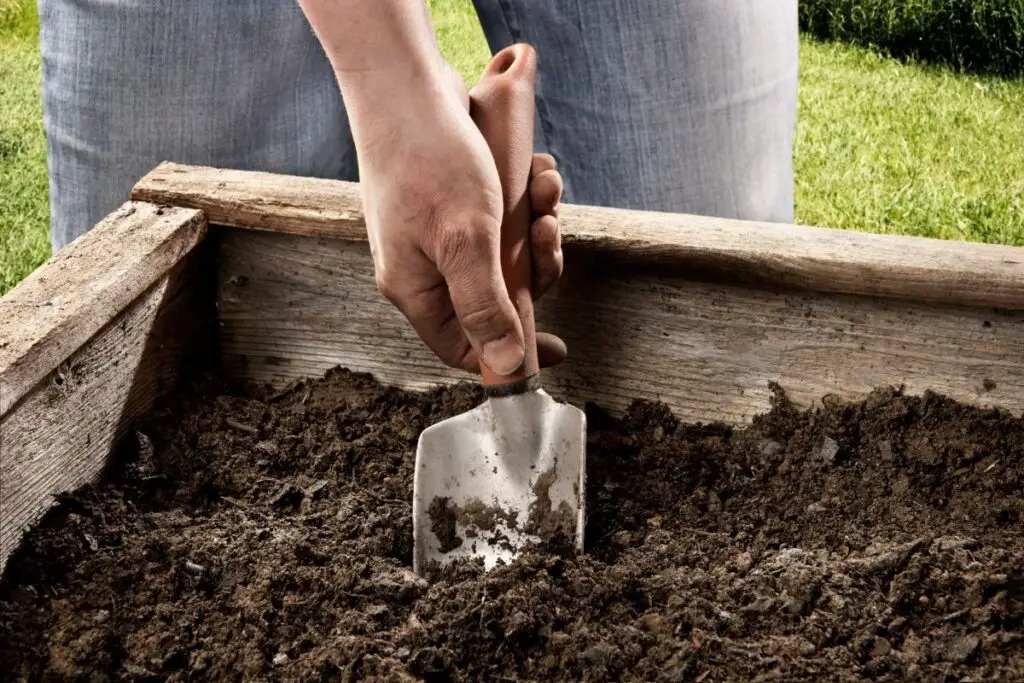
Concrete areas are alkaline.
So, this can mess up the soil’s pH level if you have not used strong barriers at the bottom.
If you are using materials that decompose, the soil will come in contact with the concrete.
Consider checking your soil pH and adjusting it from time to time as required.
If the soil is acidic, correct it with grounded limestone or wood ash.
If the soil becomes alkaline, add compost, ground sulfur, or gypsum.
Also read: 7 Best DIY Raised Bed Soil Mix
High moisture requirements
Raised beds built over concrete areas will have higher moisture needs than those built over the soil.
Once the soil drains, there is no soil under the bed to hold the moisture.
So, the plant roots will dry up faster than those growing in the ground, especially if you are using very well-drained soil.
So, you must water them more often to maintain moisture consistency.
No benefits from beneficial bacteria and earthworms
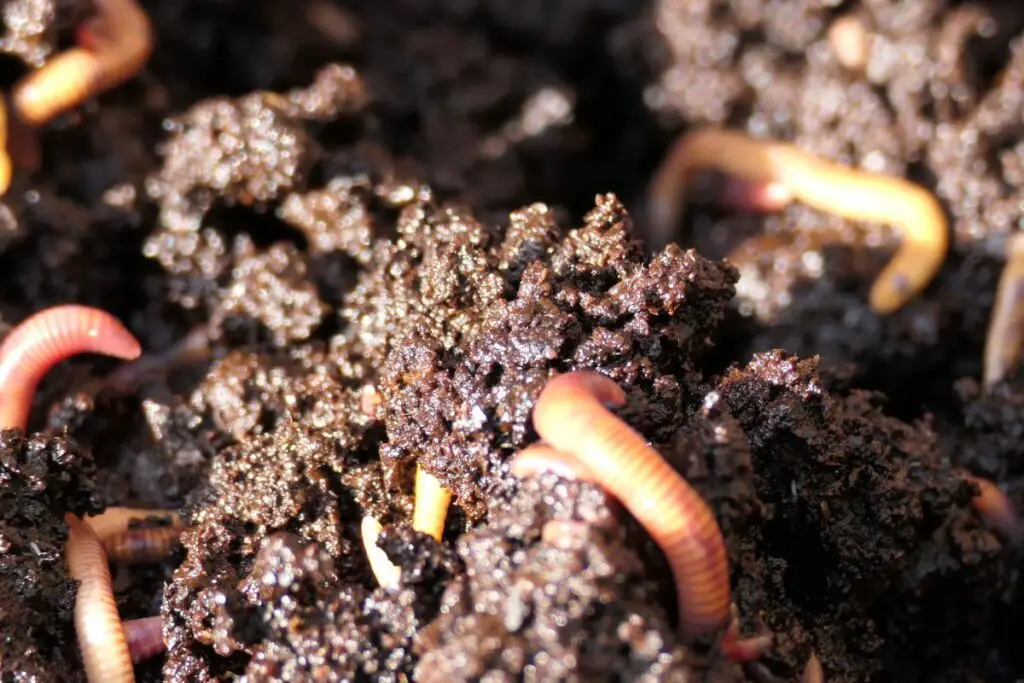
The plants of raised beds over concrete areas don’t benefit from the beneficial earthworms that get into the bed from the soil under the garden bed.
These beneficial bacteria and earthworms enter the soil and increase the soil quality and plant health.
The earthworms digest the soil’s organic matter and leave behind nutrient soil components.
Besides, the more they move inside the soil, they encourage soil aeration.
You must buy and add these earthworms separately to improve soil quality.
Mud stains
No matter how better you build your raised bed to prevent leakages, there will be leakages due to excessive rain or watering.
If there is no chance of water getting drained from the bottom, it will leak from above if the bed is filled with soil.
Once this happens, your raised beds will be stained with mud.
Prevent overwatering and use a soil mix that is good in water absorption.
You may also cover the raised bed during the winter and rainy seasons.
Final thoughts
Growing raised beds over concrete areas is not very difficult. But, there are certain pros and cons to it. You can solve some of the issues.
If the concrete is a bit slanted, fix the slope and then place the bed over there. Else, find a flat surface. Make sure the bed is a bit taller so that the deep-rooted plants can get proper space to develop and access the moisture and nutrients.
Also, fix the drainage system of the raised beds. Don’t forget to create a bottom for the raised beds to avoid waterlogging and leakages.
Reference: ScienceDirect, American Society of Agronomy, Noble Research Institute, Soil for Raised Beds, Raised Bed Gardening.
